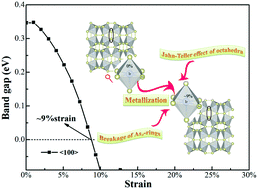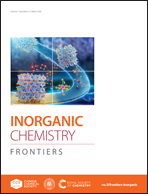Strain-engineering enables reversible semiconductor–metal transition of skutterudite IrAs3†
Abstract
Strain engineering is a more effective and green method to achieve the nonmetal-to-metal transition than metal doping. The elastic strain field can effectively change the atomic orbital interaction, achieving the metallization of materials. Taking IrAs3 as a prototype, the strain–stress behaviors of binary skutterudite are investigated. A reversible semiconductor-to-metal (SM) transition can be easily achieved by only an ∼9% strain. The strain-induced Jahn–Teller effect of IrAs6 octahedra and the breakage of As4-rings dominate the metallization. Unexpectedly, the metal element Ir in IrAs3 becomes an electron acceptor due to its higher electronegativity and the effect of the octahedral field.



 Please wait while we load your content...
Please wait while we load your content...